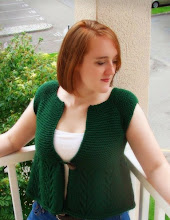This claim has been put to the test because my charity knitting group gives us yarn for our projects. That's right, free yarn for all the knitting I could dream of doing as long as I'm willing to give my FOs to charity. It is all 100% acrylic yarn. It also appears to all be worsted. I am not about to complain. It is the most amazing set up I have ever encountered. Now I find myself working with acrylic yarn on almost a daily basis. Has it changed my opinion at all? Not really. I limit my time working with the charity projects, because they start to feel rough on my fingers. Though all of my other projects feel like butter sliding through my hands. So it is free yarn and it helps my appreciate my expensive yarn more. It is delightful on so many levels.
I recently finished my first charity project and fell right into a subargument of the pro and anti acrylic debate: Can you block acrylic? After reading articles and watching videos from both sides, I've reached an initial opinion and I'm using my charity projects to test it. First let me hash out the argument as I understand it:
Anti: You cannot wet block acrylic. I tried this with some of my very first learning to knit projects, and I can confirm that soaking a project and laying it out to dry will not do you much good. It also won't do you much harm.
Pro: Steam! Wet blocking is not the only type of blocking and you should choose a method appropriate to your project and fiber. In the case of acrylic, that's steam blocking.
Anti: That's not blocking; it's melting! The hot steam is melting the plastic based fiber into submission and by definition ruining the yarn.
Pro: It works, and it works better than wet blocking because you don't have to re-block every time you wash you FO.
This last argument is the one that sold me. I generally believe that blocking makes projects look better and I do it with everything except my toys (though I've had some toy pieces that made me consider it.) I am not a perfectionist when it comes to my knitting. I'm often fudging fixes rather than correcting mistakes, but I do want my final piece to look its best. I have a clothing steamer that we keep out and use on almost a daily basis, so there really was no hassle to trying. I finished seaming and sewing in ends on my Dream Catcher and it looked a little sad. I wrapped it up in an icord boarder and it still had a wonkyness to it that I couldn't shake.
As you can see the squares didn't want to be square and the boarder was curling under in some places and curling out in others. It is not what I wanted to present to the group as my very first project. Since this was an experiment, I let myself be a bit lazy. I didn't pin this or measure out perfect squares. I just threw a beach towel on my table and laid the blanket down on top (RS down per all the instructions I've seen online.) I went at it with my steamer pretty haphazardly. I tugged here and patted there and really avoided overly committing or stressing myself.
I'm happy to report that even with my poor attempt it calmed down nicely. Here it is drying. It was a little damp so I left it for a bit and it held its shape wonderfully. I'm certain with a measuring tape and a right angle I could have made perfect squares and straight lines. I only blocked the one side. I've seen some tutorials on crochet blankets recommend doing both sides, but knitting tutorials say only the back. I think the reason is that one side is all that would be necessary for something like this and if you are working very textured, I could see the benefit of only blocking the back and not 'flattening' the front.
My initial conclusions. It works and it is worth it. My blanket now has the pretty finished look that a blocked FO should have. I didn't wash it to test if the blocking was permanent. I suspect that both the pro and anti acrylics are right here and it is a case of slight melting. My yarn didn't get shiny, there were no plastic drippy balls like if I took an open flame to it, and it certainly didn't make the texture rough or unpleasant. I don't plan on this yarn being anything other than this blanket so if I've just convinced it of the same, so be it. My next blanket has a hint of laciness to it, so we'll see if blocking can help open up a project.
Hubby has taken some FO pictures of this project with his fancy camera so hopefully I'll be sharing those soon.





No comments:
Post a Comment